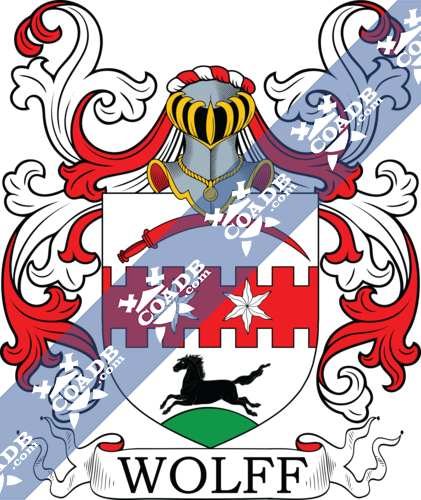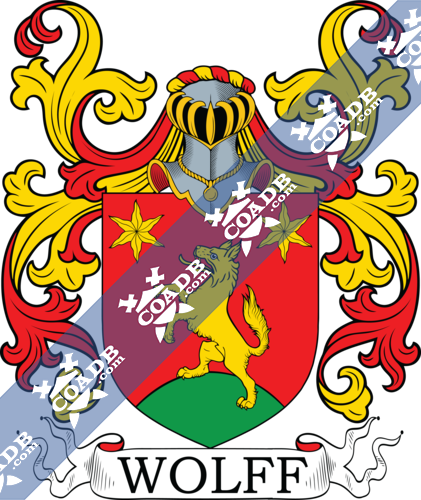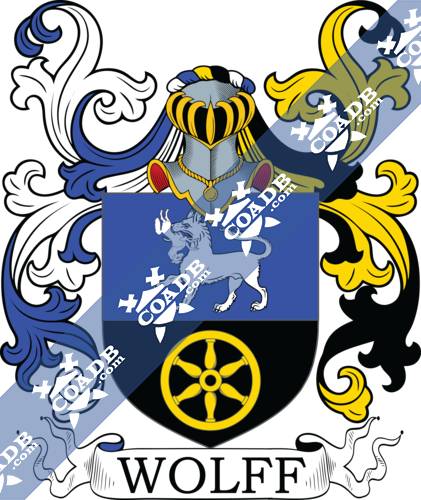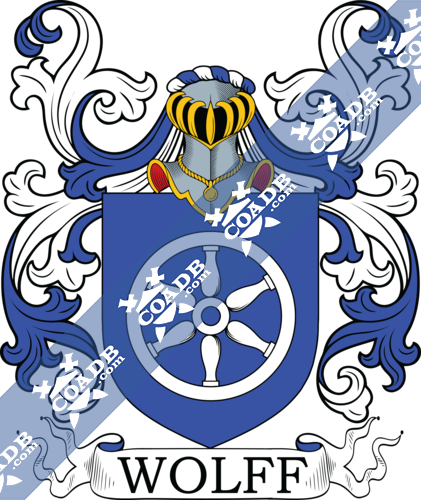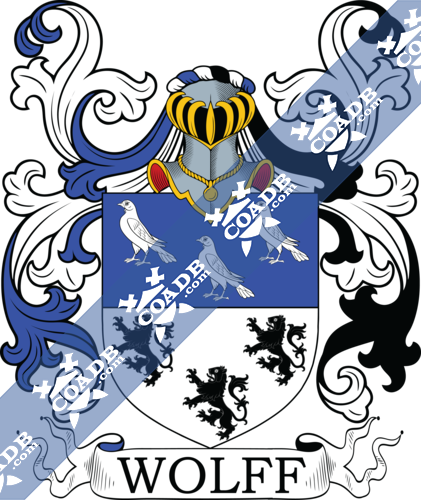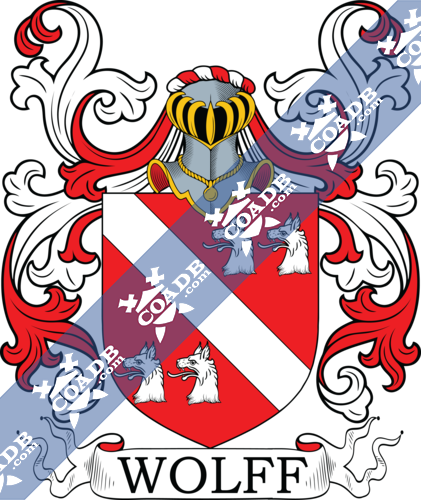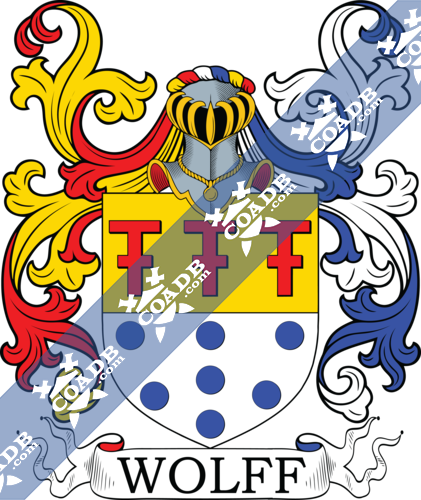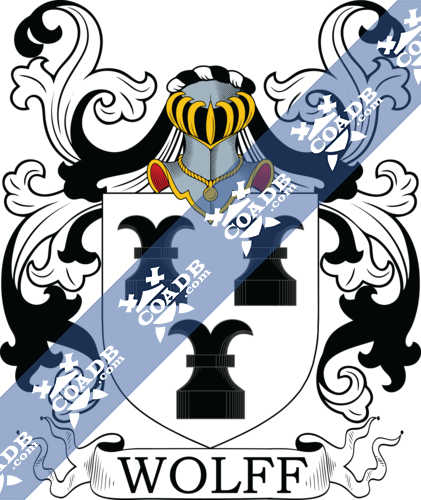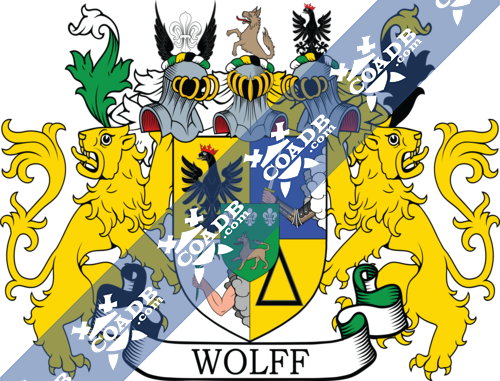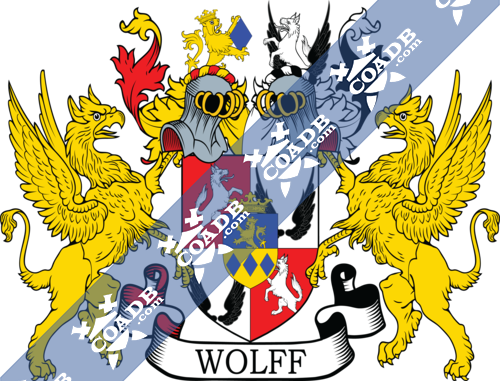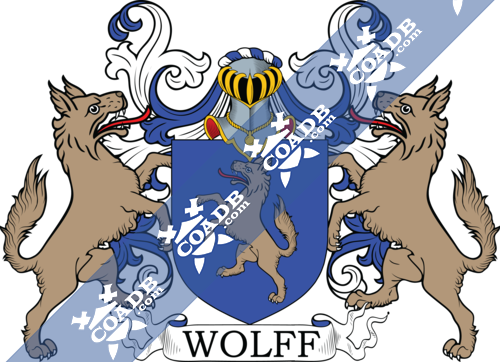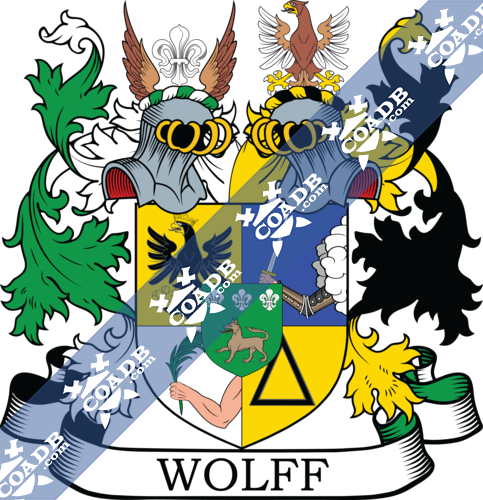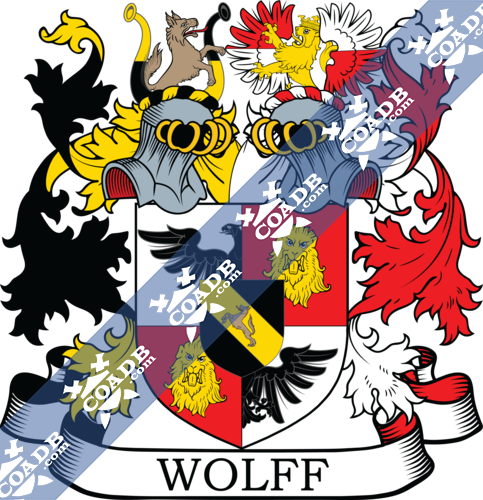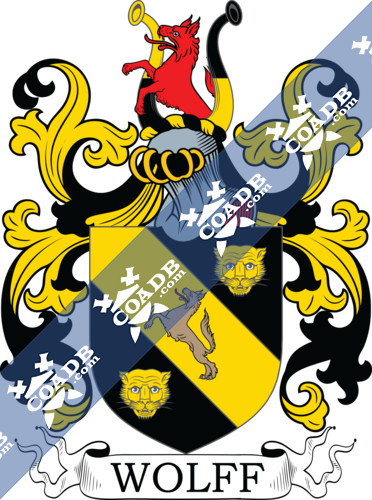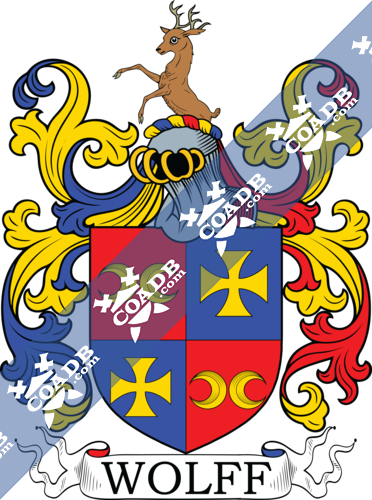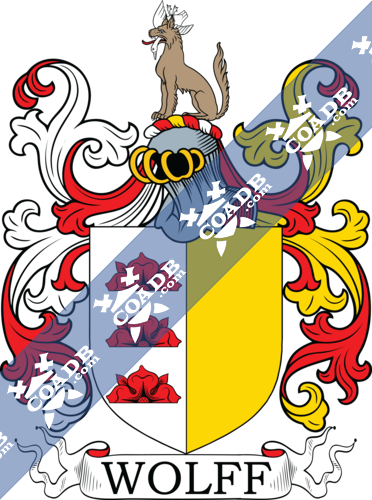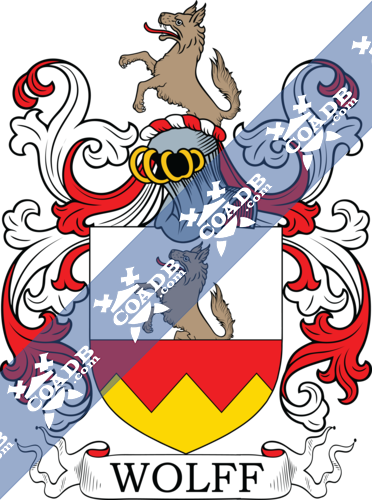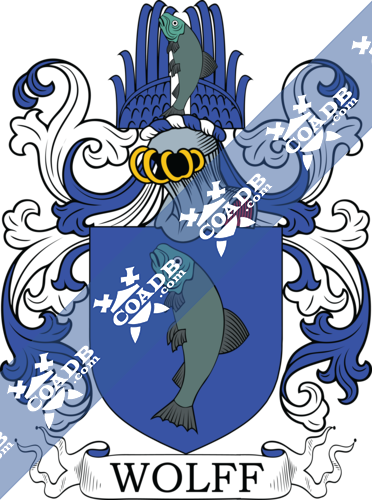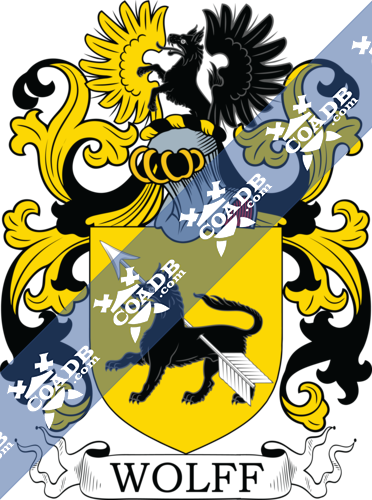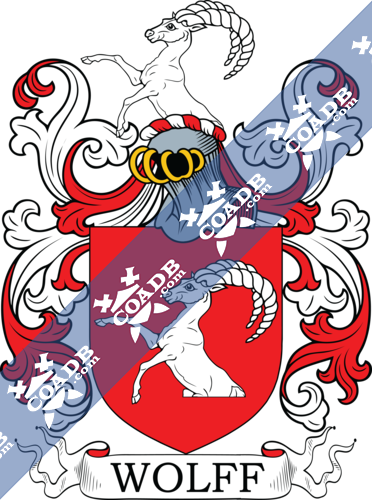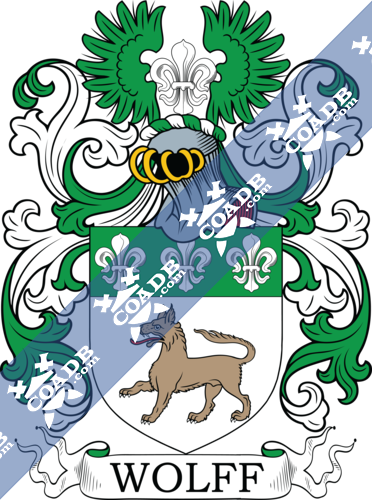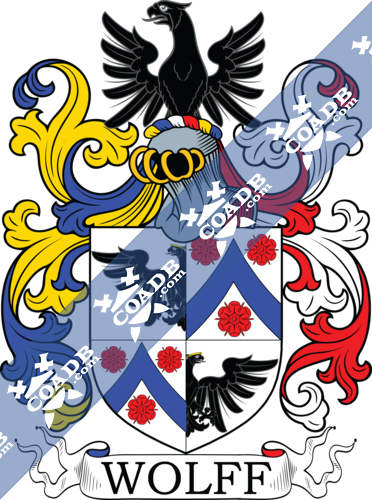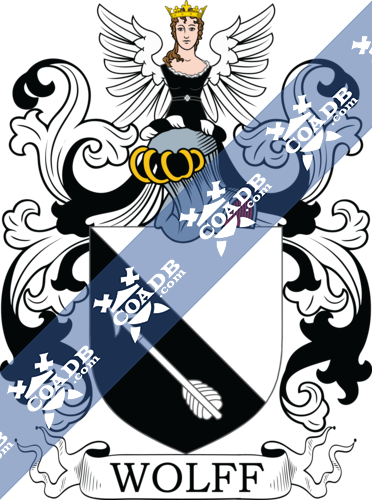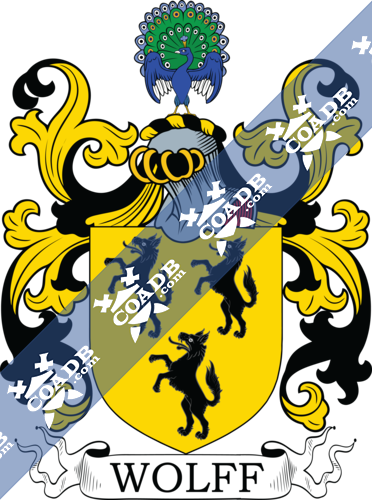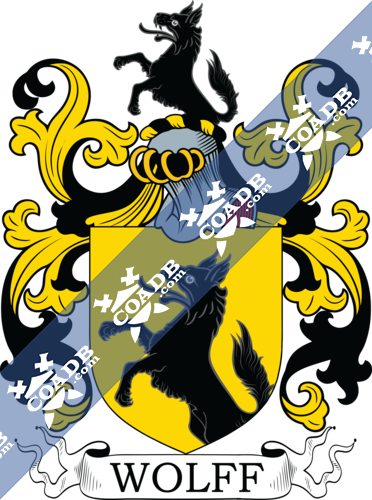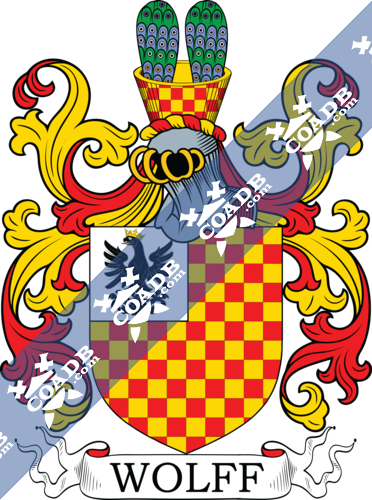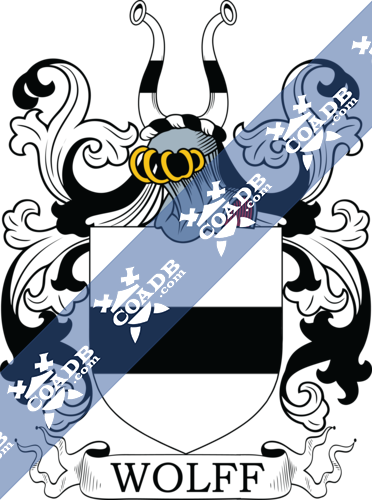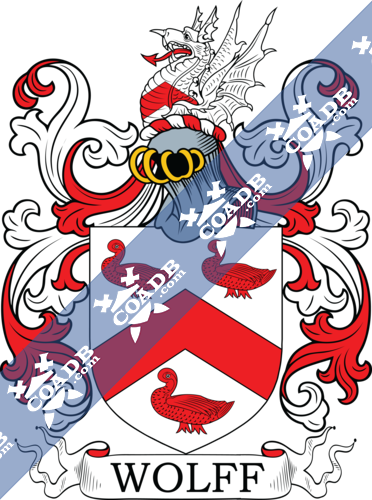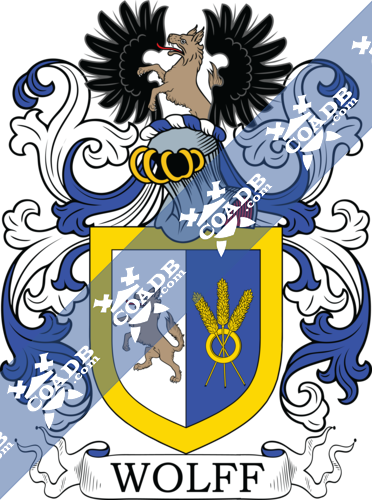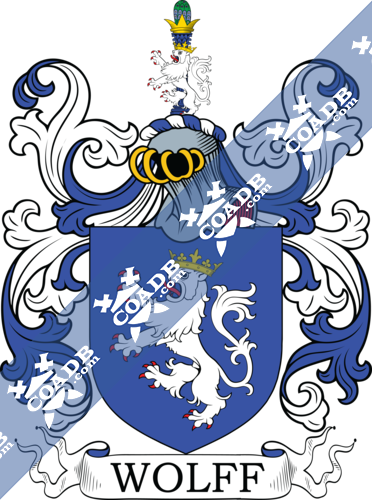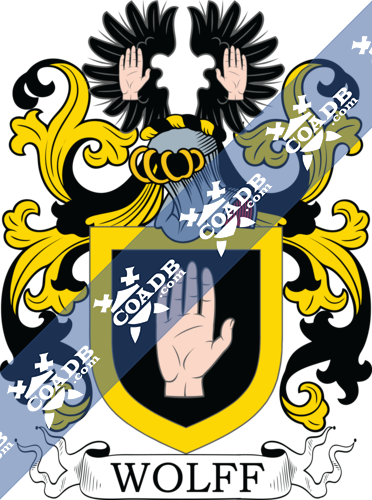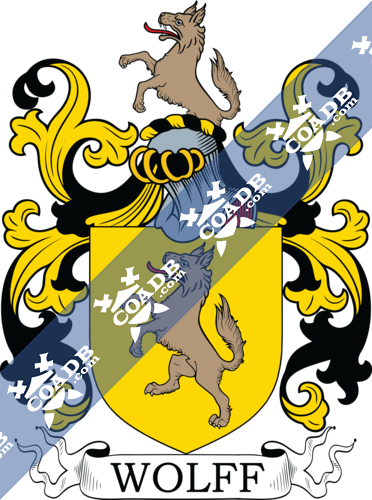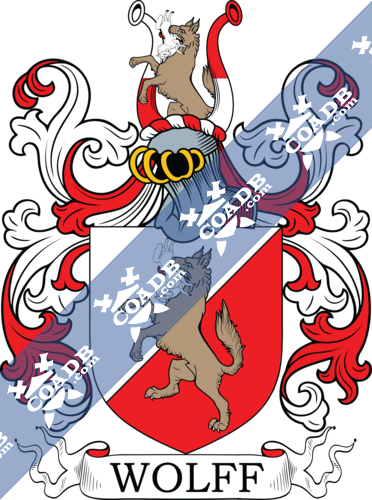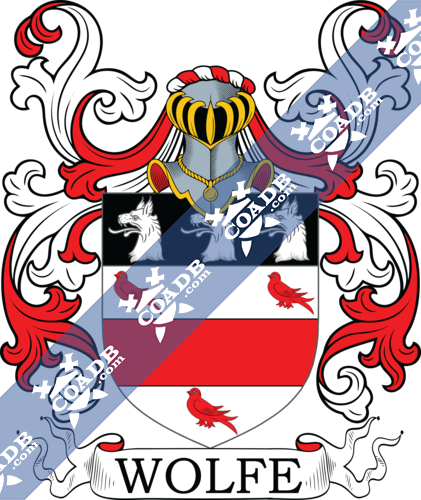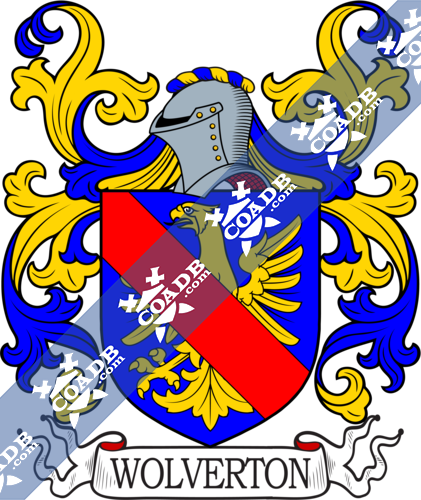Wolff Family Crest, Coat of Arms and Name History
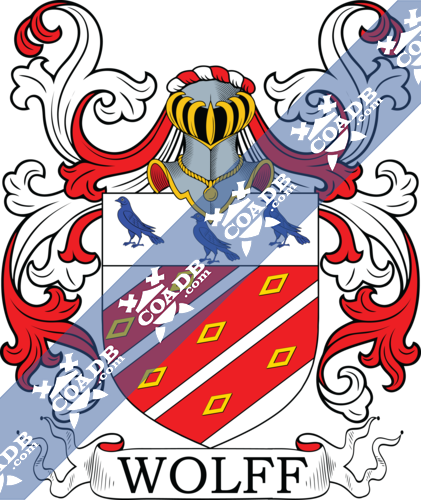
Wolff Coat of Arms Gallery
Don’t know which Coat of Arms is yours?
We can do a genealogical research. Find out the exact history of your family!
Learn MoreSurname Name Meaning, Origin, and Etymology
This surname has three origin theories. First, it is a nickname “the wolf” given to a person who resembles the animal in terms of physical traits or personality characteristics. The animal is a prominent and sacred one in Germanic mythology and was regarded as a sacred beats of Woden (or Odin in Scandinavia, the most prominent god).
Second, it is a baptismal surname meaning “the son of wolf” or “the son of ulf, which is an ancient personal (first) name used throughout Europe including England, Iceland, and Denmark. There are numerous locales throughout the British Isle bearing the root of this nameL: Wolverton, Ulverston, Wolvesey, Wolvercote,, Wolverhampton, Wolferton, and more.
Third, it is a baptismal surname meaning “the song of Wolfgang”, an old Germanic personal name deriving from the Old German word wolf and ganc, meaning battle.
Spelling Variations
Common spelling variants include Wolff, Wolfe, Wulf, Wolfe, Woolf, Woolfe, Wulff, and Woolf. Please run a search for Wolff and Wolfe, as we have separate pages with different coats of arms for those surnames. There are also many other names bearing this name, including: Wolfhound, Wolfhunt, Wolfraven, Wolfson, Woolfso, and Wulfson. In Ireland, it is a varied spelling of Woulfe.
Popularity & Geographic Distribution
The last name ranks 427th in the United States according to the 2000 Census. The variant Wolff is ranked 1,543rd and Wolfe is ranked 337th. The name is most common in New York, Pennsylvania, the Midwest, and California. The name also has notable density in Austria, Germany, France, and Brazil.
Early Bearers of the Surname
A one Ulf, son of Tur-ulf was present at the foundation of St. Mary’s Priory in Lancaster. A one Ulf married the sister of Canute (King of Denmark, England, and Norway, known as the North Sea Empire, who was called called King Cnut The Great, who reigned from 1016-1035 AD) and was the third Bishop of Dorchester. The Pipe Rolls of Cumberland, Westmoreland, and Durham (also called the Sheriff’s Annuial Accounts) records Ulf de Appelbi in 1163 and Ulf Strodhyrda in 1196 AD.
The Pipe Rolls of Lincoln in 1166 AD list one Robert Wulf. The Hundred Rolls of 1273 AD, a census of Wales and England, known in Latin as Rotuli Hundredorum, documents three people bearing this surname: John le Wlf in Sussex, Agnes le Wolf in county Huntingdonshire, and Emma le Wolf in Bedfordshire. The Poll Tax of Yorkshire in 1379 lists Magota Wlfe. The Register of the University of Oxford of 1586 records one Thomas Wolphe (or Wulph) in county Wiltshire. The Rolls of Parliament document the existence of Adam le Wolf, as well as Philip le Wolf in 1306 AD. Roger Ulfe and William filus Ulfe were recorded in 1250 AD in the Cartularium Abbathiae de Whiteby.
History, Genealogy, and Ancestry
One source claims the family Wolf was first found in the Rhineland and in the 1200s it spread throughout Germany and later came to England during the Norman Invasion of 1066 AD. A one Elbel Wolf of Bruen, Moravia was documented as in 1365 AD.
The name Wolfe was first established in Cheshire and they descended from Hugh Lupus, Earl of Chester. The word lupus is Latin meaning wolf.
The famous genealogist Bernard Burke’s book “The Landed Gentry” discusses two branches of this family: Wolfe of Woodhall and Wolfe of Forenaghts. The first begins with a mention of Thomas Birch-Wolfe, Esq. of Wood Hall in county Essex, who married Eliza Vernon, daughter of Reverend Richard Birch, in 1831.
The second is a lengthier discussion and begins with a mention of Richard Wolfe, Esq. of Forenaghts and Bishopland in county Kildare, who was a 2nd Lieutenant of the 3rd Royal Scots Grey. He was born in 1855 and succeeded his father in 1872. Burke states this family is of great antiquity and names several prominent members of this branch, including Major General James Wolfe, the hero of Quebec, Arthur Wolf, the Viscount Kilwarden, and the Reverend Charles Wolfe, a poetic genius. John Wolfe, Esq. of Baronrath, was son of Richard Wolfe, and was appointed a Commissioner by King William III of England. In 1668, he married Mary Cooper, widow of Thomas Colclough. He died in 1715 and left behind a son named Richard who was born in 1673. In 1669, Richard married Lydia, daughter of Patrick Page and Mary Sandys, and had children with her: John, Thomas (of Blackhall born 1705 and married Margaret Lombard), Theobald (born 1710, Barrister-at-Law, who married Elizabeth Dobbs), and Richard (of Baronrath, born 1712 and married Alicia Standish). He died in 1732 and was succeeded by his eldest son John. John was born in 1700 and in 1725, he married Mary, daughter of William Phillpott and had issue with her: Philpott and Arthur (Lord Kilwarden born in 1738). He died in 1760 and was succeeded by his son Philpott Wolfe, Esq. of Forenaughts, born in 1723 who married Mary, daughter of Thomas Burgh, in 1753. He left a son and successor named John, born 1754, who was Colonel in the Kildare Militia. In 1777, he married Charlotte, daughter of Theobald Wolfe, and had issue with her: John (1778), Arthur (1786), and Richard. He died in 1816 and was succeeded by his only surviving son, Reverend Richard Wolfe. He was born in 1787 and in 1831, he married Lady Charlotte Sophia Hutchinson, sister of John, 2nd Earl of Donoghmore, and he died without issue. He was succeeded by his relative Theobald George Samuel Wolfe, Esq. of Forenaghts and Bishopland. He was born in 1815 and in 1852 he married Henrietta Elizabeth, daughter of Henry Moreland Ball. He had issue: Richard, George (1859), and Elizabeth. This family bore the following coat of arms: Argent, three wolf’s heads erased sable ducally gorged or, with crest: A wolf’s head sable ducally gorged or.
A one Edward Wolfe was born in 1615 in England. He married Margaret Southerne and together they had a son named Edward, born in 1685, who became a Lieutenant General. In 1723, he married Henrietta Thompson and had three people with her: Edmund, James, and Edward. His son James, born in 1727 in Westerham, Kent, became a Major General. He died in 1759 in Quebec. The son Edmund was born in 1720 and had a daughter named Frances (Cornwell).
A one William Washington Wolf was born in 1830 in Indiana. In 1857, he married Naomi Pulliman and they had numerous issue together: Jasper, Arizona (Kirkpatrick), John M., Ulysses S.G., Nancy Lavina (Becker), William B. and Neoma (George).
A one Johann Claus Wolf was born in Spock, Karlsruhe, Germany in 1619. He married Martha Seger and together they had a son named Johann Conrad. Johann was born in 1648. He married Anna Eva and they had a daughter named Anna Barbara (Wolf) Stober.
Thiebault Wolf was born in 1595 in Ilfurth, France. In 1621, he married Odile Schwebler and together they had a son named Thibaut Wolf IV who was born in 1630 in the same city. He in turn had a daughter named Appoline.
Early American and New World Settlers
A one Emanuell Wolfe came in the ship named Thomas and Susan to Boston in 1679. Other early settlers include Claes Wolf (New Netherlands 1658), Thomas Wolf (Philadelphia 1683), John George Wolf (New England 1709), Hans Bernard Wolf (Philadelphia 1727), Magdalena Wolf (Halifax, Nova Scotia 1742), Peter Wolfe (Salem, MA 1634), William Wolfe (Maryland 1640), Richard Wolfe (Virginia 1646), Anna Margaret Wolfe (New York 1710), Robert Wolfe (Nova Scotia 1750), Paul Wolff (Pennsylvania 1691), Bertram Wolff (New York 1710), and Freiderich Wolff (Nova Scotia 1757).
Mottoes
There are numerous mottoes for the Wolf, Wolfe, and Wolff family: 1) Pro patriae amore, meaning “For patriotism”, 2) Dante Deo, meaning “God willing”, 3) Virtutis praemium, meaning “Honor is the reward of virtue”, 4) Fides in adversis, meaning “Faith in adversity”, 5) Ostra Contrariis, meaning “unknown?”.
Grantees
Later people bearing this surname that bore the arms: 1) Wolfe (Birch-), Kev. Richard ?, of Woodhall and Widdington, co. Essex. Quarterly Arms, 1827, 2) Wolfe, Rev. Richard (Rev. William ?), M.A., Camb., of Widdington, co. Essex, Rector of Hardwicke. Quarterlv Arms, 1859 and 3) Rev. William (Thomas?), of Woodhall, co. Essex, 1864.
Notables
Famous people with this last name include: 1) Dragutin Wolf (1866-1927) who was a Croatian Jewish industrialist, 2) Maurice de Wulf (1867-1947) who was a Belgian Thomist (from Thomas Aquinas) philosopher, 3) Markus Johannes Wolf (1923-2006) who was head of East German’s Main Directorate Reconnaissance, 4) Rudolf Wolf (1816-1893) who was a Swiss mathematician and astronomer known for his research on sunspots, 5) Lieutenant Colonel Joseph Wolff (1788-1863) who was a British solider that served in the military under the Duke of Wellington, and 6) Charles Wilfe (1791-1823) who was an Irish poet.
To receive a complete surname meaning report by PDF you can order our SURNAME MEANING PACKAGE for $129. This report is great to share with family and friends. It includes everything you see above plus any other information we can find on the specified surname. It does take approximately 10 to 15 days for us to complete this custom report.
To receive a direct lineage & coat of arms search for your specific line(s) you can order one of our GENEALOGY PACKAGES ranging in price from $249 to $999. All research is completed by a professional genealogist with over 30 years’ experience. All reports and coat of arms files are sent by email in PDF and JPG format.
Blazons & Genealogy Notes
1) Prusse – (An., 23 août 1563; conf. de nob., 27 mars 1743) – De sable à la bande d’or ch d’un loup courant au naturel et acc de deux têtes de léopard du second Cimier le loup issant entre deux proboscides coupées alternativement d’or et de sable English: Sable a bend or charged with a wolf courant [running] proper and accompanied by two leopard’s faces of the second; Crest: the wolf issuant between two proboscides per fess alternately or and sable.
2) Prusse – (Barons du St-Empire, 10 sept. 1745) – Écartelé aux 1 et 4 de gueules à un loup rampant d’argent celui du 1 contourné aux 2 et 3 d’argent à deux demi-vols adossés de sable Sur le tout un écusson couronné d’or coupé a d’azur au lion naissant d’or couronné du même mouv du coupé b d’or à trois losanges d’azur rangées en fasce Deux casques couronnés Cimiers 1° le lion issant et contourné tenant entre ses pattes une losange d’azur Lambrequin d’or et de gueules 2° le loup du 4 issant entre un vol de sable Lambrequin d’argent et de sable Supports deux griffons d’or English: Quarterly: 1st and 4th – gules a wolf rampant argent, that of the 1st reversed; 2nd and 3rd – argent two single wings addorsed [back to back] sable; overall an escucheon crowned or per fess: a) azure a lion naissant or crowned of the same, coming from the partition line; b) or three lozenges azure arranged in fess; Crowned with two helmets – Crests: 1st the lion issuant and reversed, holding between its paws a lozenge azure; Mantling: or and gules; 2nd the wolf from the 4th issuant, between a pair of wings sable; Mantling: argent and sable; Supporters two griffins or.
3) P. de Spire – De gueules à un bouquetin naissant d’argent Cimier le bouquetin issant English: Gules an ibex naissant argent; Crest: the ibex issuant.
4) Prusse – (An., 2 oct. 1786) – Parti au 1 d’argent à un loup rampant au naturel au 2 d’azur à trois épis effeuillés d’or 2 passés en sautoir et 1 brochant en pal réunis au moyen d’un annelet d’or L’écu bordé du même Casque couronné Cimier le loup issant entre un vol de sable Lambrequin d’argent et d’azur English: Per pale: 1st argent a wolf rampant proper; 2nd azure three ears of wheat leafless or, 2 placed saltirewise and 1 covering over them palewise, bound together by an annulet or, the shield within a bordure of the last; Crowned with a helmet – Crest: the wolf issuant between a pair of wings sable; Mantling: argent and azure.
5) Prusse occidentale – (An., 18 oct. 1861) – D’or à un loup rampant au naturel le champ chapé-ployé d’azur à deux fleurs-de-lis d’argent au chef de l’écu de pourpre ch d’une couronne royale d’or Cimier un loup issant au naturel entre un vol d’azur chaque aile ch d’une fleur-de-lis d’argent Lambrequin à dextre d’or et de sable à senestre d’argent et d’azur English: Or a wolf rampant proper, the field chapé-ployé azure, in chief two fleur de lys argent, above all a chief purpure charged with a Royal crown or; Crest: a wolf issuant proper between a pair of wings azure, each wing charged with a fleur de lys argent; Mantling: to the dexter or and sable, to the sinister argent and azure.
6) Zweibrücken (Bavière) – De sable à une main dextre appaumée de carnation à la bordure d’or Cimier un vol de sable l’aile dextre ch de la main de l’écu l’aile senestre ch d’une main senestre appaumée de carnation Lambrequin d’or et de sable English: Sable a dexter hand apaumee carnation, a bordure or; Crest: a pair of wings sable, the dexter wing charged with the hand from the shield, the sinister wing charged with a sinister hand apaumee carnation; Mantling: or and sable.
7) Ratisbonne – D’or à un loup rampant au naturel Cimier le loup issant Lambrequin d’or et de sable English: Or a wolf rampant proper; Crest: the wolf issuant; Mantling: or and sable.
8) Valais – D’or à un loup rampant de sable langué de gueules English: Or a wolf rampant sable, langued gules.
9) Nuremberg – Taillé d’argent sur gueules à un loup rampant au naturel brochant sur le taille et ravissant un agneau du premier Cimier le loup issant entre deux proboscides coupées alternativement d’argent et de gueules English: Per bend sinister argent over gules, a wolf rampant proper covering over the partition line and devouring a lamb of the first; Crest: the wolf issuant between two proboscides per fess alternately argent and gules.
10) Amsterdam – D’argent à trois barres de gueules ch de sept macles d’or 2 3 et 2 posées dans le sens des barres au chef du premier ch de trois oiseaux d’azur 2 et 1 English: Argent three bendlets sinister gules, charged with seven mascles or – 2, 3 and 2, placed in the direction of the mentioned bendlets, a chief of the first charged with three birds azure – 2 and 1.
11) Angleterre – (Barons du St-Empire, 22 sept. 1747; baronet, 18 oct. 1766. M. ét. le 3 fév. 1837) – Écartelé au 1 d’or à l’aigle de sable couronnée de gueules au 2 d’azur à un senestrochère armé au naturel issant d’une nuée mouv du flanc et tenant une épée d’argent garnie d’or au 3 d’argent à un senestrochère de carnation tenant une palme de sinople et issant d’une nuée au naturel mouv du parti au 4 d’or à un triangle vidé de sable Sur le tout de sinople à un loup passant au naturel acc de trois fleurs-de-lis d’argent rangées en chef Trois casques couronnés Cimiers 1° une fleur-de-lis d’argent entre un vol de sable 2° le loup issant 3° l’aigle du 1 Lambrequin à dextre d’argent et de sinople à senestre d’or et de sable Supports deux lions regardants d’or Devise DANTE DEO English: Quarterly 1st or an eagle sable crowned gules; 2nd azure a left arm armoured proper, issuant from a cloud coming from the flank and holding a sword argent, hilt and pommell or; 3rd argent with a left arm carnation holding a palm branch vert and issuant from a cloud proper coming from the partition line; 4th or with a triangle voided sable; on an escutcheon vert a wolf passant proper accompanied by three fleur de lys argent arranged in chief; Crowned with three helmets – Crests: 1st a fleur de lys argent between a pair of wings sable; 2nd the wolf issuant; 3rd the eagle from the 1st quarter; Mantling: to the dexter argent and vert, to the sinister or and sable; Supporters: two lions reguardant or; Motto: DANTE DEO.
12) Allemagne – Écartelé aux 1 et 4 de gueules à deux croissants adossés d’or aux 2 et 3 d’azur à la croix pattée alésée d’or Casque couronné Cimier un chevreuil issant au naturel Lambrequin à dextre d’or et d’azur à senestre d’or et de gueules English: Quarterly: 1st and 4th gules two crescents addorsed [back to back] or; 2nd and 3rd azure with a cross pattee or; Crowned with a helmet – Crest: a roe deer issuant proper; Mantling: to the dexter or and azure, to the sinister or and gules.
13) Alsace – (Chevalier Wolf, 29 août 1810, baron , en Westphalie 16 septembre 1813, baron héréditaire 11 juin 1819) (Vic. Révérend) – D’argent à la fasce bretessée de gueules chargée de deux étoiles d’argent acc en chef d’un sabre de gueules posé en fasce et en pointe d’un cheval galopant de sable soutenu de sinople English: Argent a fess crenelle gules charged with two estoiles argent, accompanied by in chief a sabre gules placed fesswise and in base by a horse courant sable over a mount vert .
14) Berne – De gueules à un loup rampant d’or soutenu d’une terrasse de sinople et acc en chef de deux étoiles du second English: Gules a wolf rampant or standing on a mount vert and accompanied in chief by two etoiles of the second.
15) Esthonie – (Barons du St-Empire, 22 sept. 1747) – Écartelé au 1 d’or à l’aigle de sable becquée membrée et couronnée d’or au 2 d’azur à un senestrochère armé au naturel sortant d’une nuée mouv du flanc la main de carnation tenant une épée d’argent garnie d’or au 3 d’argent à un senestrochère de carnation mouv du parti tenant une palme de sinople au 4 d’or à un triangle vidé de sable Sur le tout de sinople à un loup passant au naturel acc de trois fleurs-de-lis d’argent rangées en chef Deux casques couronnés Cimiers 1° une fleur-de-lis d’argent entre un vol de couleur brunâtre Lambrequin d’argent et de sinople 2° l’aigle Lambrequin d’or et de sable English: Quarterly: 1st or an eagle sable, beaked, legged and crowned of the field; 2nd azure a left arm armoured proper, issuing from a cloud coming out of the flank, the hand carnation holding a sword argent, hilt and pommell or; 3rd argent a left arm carnation coming from the partition [pale] line, holding a palm branch vert; 4th or a triangle voided sable; On an escutcheon vert with a wolf passant proper, accompanied by three fleur de lys argent arranged in chief; Crowned with two helments – Crests: 1st a fleur de lys argent between a pair of wings in brownish color; Mantling: argent and vert; 2nd an eagle; Mantling: or and sable.
16) Franconie – Parti au 1 d’argent à trois moitiés supérieures de roses de gueules rangées en pal au 2 d’or plein Cimier un loup assis au naturel tenant entre ses dents une oie d’argent Lambrequin à dextre d’argent et de gueules à senestre d’or et de gueules English: Per pale: 1st argent the upper halves of three roses gules arranged palewise; 2nd or plain [uncharged]; Crest: a wolf sejant proper holding between its teeth a goose argent; Mantling: to the dexter argent and gules, to the sinister or and gules.
17) Cologne – (Conc. d’arm., 2 mai 1649) – Coupé au 1 d’argent à un loup naissant au naturel mouv du coupé au 2 coupé-vivré de gueules sur or Cimier le loup issant Lambrequin d’argent et de gueules English: Per fess: 1st argent a wolf naissant proper, coming from the partition line; 2nd per fess [right angled] dancetty gules over or; Crest: the wolf issuant; Mantling: argent and gules.
18) Dresde – (Conc. d’arm., 25 avril 1566; nob. du St-Empire, 11 sept. 1745) – D’azur à un poisson courbé en pal au naturel Bourlet d’azur et d’argent Cimier le poisson en pal devant un vol à l’antique d’azur Lambrequin d’argent et d’azur English: Azure with a fish curved palewise proper; Wreath on the helmet: azure and argent; Crest: the fish palewise in front of a pair of ancient wings azure; Mantling: argent and azure.
19) (de Wolff) Gorinchem – Coupé au 1 d’azur à un loup ravissant un agneau d’argent au 2 de sable à une roue d’or English: Per fess: 1st azure with a wolf devouring a lamb argent; 2nd sable a wheel or.
20) (de Wolff) Hainaut – (Chevaliers du St-Empire, 26 fév. 1760. M. ét. le 20 juillet 1829) – D’azur à un loup au naturel Supports deux loups au naturel English: Azure a wolf proper; Supporters: two wolves proper.
21) (de Wolff) P. d’Utrecht – D’argent à un loup ravissant un agneau au naturel English: Argent with a wolf devouring a lamb proper.
22) (de Wolff) Flandre – D’azur à une roue de six rayons d’argent English: Azure a wheel with six spokes argent.
23) (de Wolff) Amsterdam – Coupé au 1 d’azur à trois oiseaux d’argent au 2 d’argent à trois lions de sable (Beau-frère du poète Vondel) English: Per fess: 1st azure three birds argent; 2nd argent three lions sable.
24) (de Wolff) Amsterdam – D’argent à trois loups courants de sable au chef d’azur ch de trois merlettes d’or English: Argent three wolves courant [running] sable, a chief azure charged with three merlets [without beaks or feet] or.
25) (de Wolff) Amsterdam – De gueules à la bande d’argent acc de quatre têtes de loup du même 2 en chef accostées et 2 en pointe accostées English: Gules a bend argent accompanied by four heads of wolf of the same, 2 in chief side by side and 2 in base also side by side.
26) (van Der) Hollande – D’or à un loup passant de sable blessé par une flèche du même enfoncée en bande en son dos la pointe en haut Cimier un loup issant de sable entre un vol d’or et de sable English: Or a wolf passant sable pierced trough the back by an arrow of the same in bend, the point upwards; Crest: a wolf issuant sable between a pair of wings or and sable.
27) (van Der) Zélande – D’argent à un loup rampant de sable sur une terrasse de sinople English: Argent a wolf rampant sable on a mount vert.
28) (van Der) Hollande – Coupé au 1 d’or à trois potences rangées de gueules chacune croisée d’une traverse du même au 2 d’argent à sept tourteaux d’azur 3 1 2 et 1 English: Per fess: 1st or three potents arranged fesswise gules each crossed trough the middle of the same; 2nd argent with seven roundels azure 3, 1, 2 and 1.
29) (van Der) Hollande – D’argent à trois rocs d’échiquier de sable English: Argent three chess rooks sable.
30) (von Wolff) Courlande – (Comm. du Baron Tiepold) – D’argent au loup passant au naturel au chef de sinople chargé de trois fleurs-de-lis d’argent Cimier une fleur-de-lis d’argent entre un vol de sinople English: Argent a wolf passant proper, a chief vert charged with three fleur de lys argent Crest: a fleur de lys argent between a pair of wings vert.
31) de Carspach – Hesse – D’or à un loup rampant au naturel Cimier le loup issant Lambrequin d’or et de sable English: Or a wolf rampant proper; Crest: the wolf issuant; Mantling: or and sable.
32) de Clairbois – Voir de Wolff de Moorsel. English: See the Arns of Wolff de Moorsel.
33) de Haller – Hesse – (An., 23 fév., 1819) – Écartelé aux 1 et 4 d’argent à la demi-aigle de sable diadémée d’or mouv du parti aux 2 et 3 d’argent au chevron ployé d’azur acc de trois roses à six feuilles de gueules Casque couronné Cimier une aigle issante de sable Lambrequin à dextre d’or et d’azur à senestre d’argent et de gueules English: Quarterly – 1st and 4th: argent with a demi eagle sable diademee or coming from the partition [pale]; 2nd and 3rd argent a chevron ploye azure, accompanied by three roses with six leaves gules; Crowned with a helmet – Crest: an eagle issuant sable; Mantling: to the dexter or and azure, to the sinister argent and gules.
34) de Heuchlingen – Souabe – Tranché d’argent sur sable le sable chargé d’une flèche d’argent en bande Casque couronné Cimier une femme issante couronnée d’or habillée de sable les bras remplacés par deux ailes d’argent English: Per bend argent over sable, the sable charged with an arrow argent placed in bend; Crowned with a helmet – Crest: a woman issuant, crowned or, dressed sable her arms replaced by two wings argent.
35) de Moorsel – Hainaut – (Nob. du St-Empire, 13 janv. 1714; barons, 18 mai 1842) – D’or à trois loups rampants de sable Casque couronné Cimier un paon rouant au naturel Devise VIRTUTIS PRAEMIUM English: Or three wolves rampant sable; Crowned with a helmet – Crest: a peacock in its pride proper; Motto: VIRTUTIS PRAEMIUM.
36) de Schörgern – Gratz (Autriche) – D’or à un loup naissant de sable mouv de la pointe Cimier le loup issant English: Or with a wolf naissant sable, coming from the base; Crest: the wolf issuant.
37) de Sponheim – Prov. rhénanes – Échiqueté d’or et de gueules au franc-quartier d’argent ch d’une aigle de sable couronnée d’or Cimier une cuve échiquetée d’or et de gueules de laquelle sortent deux queues de paon accostées au naturel Lambrequin d’or et de gueules English: Checky or and gules, a canton argent charged with an eagle sable crowned or; Crest: a (water) tank checky or and gules from which are coming out two tails of a peacock side by side proper; Mantling: or and gules.
38) de Wolffsburg – Silésie – (Conc. d’arm., 1563; chevaliers en Bohême, 4 mars 1669) – Écartelé aux 1 et 4 d’argent à la demi-aigle de sable mouv du parti aux 2 et 3 de gueules à une tête de léopard d’or Sur le tout de sable à la bande d’or ch d’un loup courant au naturel Deux casques couronnés Cimiers 1° un loup issant et contourné au naturel entre deux proboscides coupées alternativement d’or et de sable Lambrequin d’or et de sable 2° un lion issant d’or couronné du même entre un vol coupé alternativement de gueules et d’argent Lambrequin d’argent et de gueules English: Quarterly: 1st and 4th argent with a demi eagle sable coming from the partition [pale]; 2nd and 3rd gules with a head of a lion affrontee or; Over all an escutcheon sable with a bend or, charged with a wolf courant [running] proper; Crowned with two helments Crests: 1st a wolf issuant and reversed proper, between two proboscides per fess alternately or and sable; Mantling: or and sable; 2nd a lion issuant or crowned of the same, between a pair of wings per fess alternately gules and argent; Mantling: argent and gules.
39) d’Obersuntheim – Wurtemberg – D’argent à la fasce de sable Cimier deux proboscides aux armes de l’écu English: Argent a fess sable; Crest: two proboscides with the arms of from the shield.
40) (de) van Westerrode – Gueldre – D’argent au chevron de gueules acc de trois merlettes du même Cimier une tête et col de dragon d’argent lampassée de gueules le col ch d’un chevron du même English: Argent a chevron gules accompanied by three merlettes [without beak or feet] of the same; Crest: a head and shoulders of a wyvern argent, langued gules, the shoulders charged with a chevron of the same.
41) von Schutter – Silésie – Écartelé au 1 parti a d’or à la demi-aigle de sable becquée et membrée du champ mouv du parti b d’azur à un homme habillé d’une tunique de gueules de haut-de-chausses d’argent de souliers et d’un chapeau de sable tenant de sa main dextre un sabre appuyé contre son épaule et de sa senestre une bêche abaissée au naturel au 2 d’or à un mulet naissant et contourné de sable mouv de la pointe au 3 d’argent au sautoir de gueules cantonné de quatre losanges du même au 4 de gueules plein Trois casques couronnés Cimiers 1° trois flèches d’argent sans plumes Lambrequin d’or et de gueules 2° une losange de gueules Lambrequin d’argent et de gueules 3° un demi-vol de gueules Lambrequin d’or et de gueules English: Quarterly: 1st per pale – a) or a demi eagle sable, beaked and legged of the field, coming from the partition [pale]; b) azure a man dressed with a tunic gules and with high hose argent, his shoes and hat sable, holding in the dexter hand a sabre, supported on his shoulder and in his sinister hand a spade lowered, both proper; 2nd or a mule naissant and reversed sable coming out from the base; 3rd argent a saltire gules having in each quarter a lozenge of the same; 4th gules plain [uncharged]; Crowned with three helmets – Crests: 1st three arrows argent, without feathers; Mantling: or and gules; 2nd a lozenge gules; Mantling: argent and gules; 3rd a single wing gules; Mantling: or and gules.
42) von und zur Todenwarth – Saxe, Prusse, Hesse, Autriche – D’azur au lion d’argent armé et lampassé de gueules couronné d’or Casque couronné Cimier le lion devant une colonne d’azur couronné d’or sommée d’une queue de paon au naturel English: Azure a lion argent armed and langued gules, crowned or; Crest: the lion in front of a column [pillar] azure, crowned or, surmounted by the tail of a peacock proper.

